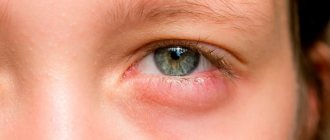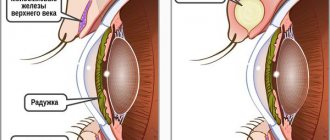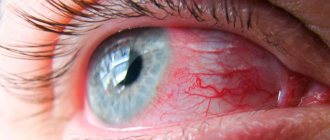Causes Symptoms Complications Diagnostics Treatment Our advantages Treatment price
Uveitis is a collective concept that covers inflammatory diseases of various parts of the choroid. The choroid (synonymous with the uveal tract) is represented by the anterior section (includes the iris and ciliary body) and the posterior section (the choroid itself - the choroid). Anatomically, these sections have separate blood supply and innervation, therefore the inflammatory process in the choroid is localized in most cases, although in some cases the entire uveal tract may be affected.
Classification
Uveitis is classified according to duration, predominant damage to one or another structure of the uveal tract, and also depending on the pathogen.
There are four types of uveitis depending on the location of the inflammation.
- Anterior uveitis is inflammation of the anterior part of the choroid, including iritis and iridocyclitis. This is the most common type of uveitis.
- Posterior uveitis (synonymous with choroiditis) is an inflammation of the posterior part of the choroid, in addition to the choroid itself, affecting the retina and optic nerve.
- Peripheral uveitis is a disease that affects the ciliary body, vitreous body, the choroid itself (choroid) and the retina.
- Panuveitis is a combined inflammation of all structures of the vascular tract.
Depending on the severity of the pathological development, uveitis can be acute or chronic.
Symptoms of uveitis development
Inflammation of the vascular part of the eye has various manifestations. This depends on the location of the lesion, the severity of the infectious process and the resistance of the body as a whole. Clinical forms have the following characteristic features:
- acute – pain in the eye, redness with a purple tint, intolerance to bright light, constricted pupil, high pressure inside the eye;
- chronic – few symptoms, slightly reddened eyes, moving dots in the field of vision;
- the anterior one occurs with an accumulation of cells on the cornea; due to adhesions with the lens capsule, cataracts, swelling of the optic nerve head, and glaucoma are formed.
- peripheral – both eyes are affected, vision is reduced, spots before the eyes;
- posterior - vision is blurred, the contours of objects are unclear, there is swelling or ischemia in the fundus, blockage of blood vessels, retinal detachment;
- generalized - more common in sepsis and causes inflammation of all layers of the eyeball, characterized by an extremely severe course and rapid loss of vision.
Watch the video about the causes of red eyes:
Symptoms
Depending on the location of the inflammatory process, the patient's complaints will be different.
With anterior uveitis, the leading symptoms will be redness of the mucous membrane of the eye, accompanied by lacrimation, photophobia, pain, a narrow pupil (miosis), blurred vision, and increased intraocular pressure.
Symptoms of posterior uveitis are usually mild and manifest themselves in the form of “floaters” before the eyes, the appearance of a veil, decreased vision, pain in the depths of the orbit and changes in the visual fields (if the optic nerve is involved in the pathological development).
With peripheral uveitis, the main manifestations will also be “floaters” in front of the eyes and blurred vision.
Patients with panuveitis may present with complaints characteristic of damage to one or another part of the uveal tract.
Uveitis and basic concepts
Uveitis (inflammatory processes in the uveal tract) in ophthalmological practice is diagnosed in 30 to 58% of cases associated with eye inflammation. Moreover, in up to 30% of cases they can result in a severe weakening of visual function up to one hundred percent blindness.
The wide variety of this pathology is associated with the strong branching of the ocular vessels and the slowing of blood flow in the uveal tract, as a result of which various microbes that cause inflammation may be retained in the membranes of the vessels.
Treatment of uveitis
The earlier the pathology is detected, and the more accurately the cause of the disease is established, the greater the chances of a positive outcome in the treatment of uveitis. The choice of treatment tactics depends on the characteristics of the disease in a particular patient. To stop the inflammatory process, local and general therapy is used (anti-inflammatory drugs, immunostimulants, pupil dilators, antibiotics, physiotherapy, etc.). A good effect for this disease is provided by the use of hirudotherapy (treatment with leeches), which is also used in our clinic. If intraocular pressure increases, antiglaucomatous drops are prescribed.
Treatment
The symptoms and treatment of this pathology are not known to everyone. For this pathology, drug therapy is carried out. The following groups of drugs may be prescribed:
- antiviral drugs;
- NSAIDs;
- mydriatics;
- systemic corticosteroids;
- antihistamines;
- cytostatics.
To eliminate spasm of the ciliary muscle, drops are prescribed that dilate the pupil. These include Atropine. The basis of therapy for patients with uveitis is the use of corticosteroids. They are prescribed in the form of tablets, drops and ointments for the eyes.
After conducting research and identifying the causative agent of infection, the specialist will be able to prescribe treatment.
If the threat comes from within, the diseased organ needs treatment first.
Without eliminating such a cause, we cannot talk about recovery, because the disease will go into the chronic phase. In this case, complex therapy is prescribed, including systemic antibacterial drugs. Local treatment works best in the presence of external irritants, but any treatment method must be agreed with doctor.
During therapy, it is also better to use general strengthening drugs, which will help strengthen the body’s immune forces and defeat the infection faster.
Folk remedies
Only an ophthalmologist can determine ocular uveitis, recognize symptoms and prescribe treatment. There are several diagnostic methods in this case:
- visual inspection;
- determination of visual acuity (visometry);
- assessment of visual fields (perimetry);
- tonometry (determination of intraocular pressure);
- biomicroscopic;
- Ultrasound scanning;
- gonioscopic (the angle of the anterior chamber of the eye is studied).
One of the main areas of treatment is the local use of steroids.
This may be Prednisolone or Dexamethasone. Steroids can be used as ointments or injections. If such therapy does not have an effect, then immunosuppressive drugs are prescribed.
If uveitis is a consequence of chlamydia, then treatment includes antihistamines, antibiotics, and fluoroquinolones.
When carrying out therapy, it is necessary to treat the root cause of the disease. When inflammation occurs against the background of an allergic reaction, antihistamines are prescribed. For infections, antimicrobial and antiviral drugs are included.
When the severity of inflammation decreases, they resort to physiotherapy - phonophoresis (using enzymes) or electrophoresis.
If there are no complications, uveitis can be treated at home.
Treatment of uveitis is complex, consisting of the use of systemic and local antimicrobial, vasodilating, immunostimulating, desensitizing drugs, enzymes, physiotherapeutic methods, hirudotherapy, and traditional medicine. Patients are usually prescribed drugs in the following dosage forms: eye drops, ointments, injections.
Traditional treatment
Treatment of uveitis is aimed at the rapid resorption of inflammatory infiltrates, especially in cases of indolent processes. If you miss the first symptoms of the disease, not only the color of the iris will change, its degeneration will develop, and everything will end in disintegration.
For drug treatment of anterior and posterior uveitis, the following is used:
- Broad-spectrum antibacterial agents from the group of macrolides, cephalosporins, fluoroquinolones. The drugs are administered subconjunctivally, intravenously, intramuscularly, intravitreally. The choice of drug depends on the type of pathogen. To do this, a microbiological examination of eye discharge is carried out for microflora and the sensitivity of the isolated microbe to antibiotics is determined.
- Viral uveitis is treated with antiviral drugs - Acyclovir, Zovirax in combination with Cycloferon, Viferon. They are prescribed for local use in the form of intravitreal injections, as well as for oral administration.
- Anti-inflammatory drugs from the group of NSAIDs, glucocorticoids, cytostatics. Patients are prescribed eye drops with prednisolone or dexamethasone, 2 drops into the affected eye every 4 hours - “Prenacid”, “Dexoftan”, “Dexapos”. Indomethacin, Ibuprofen, Movalis, Butadione are taken internally.
- Immunosuppressants are prescribed when anti-inflammatory therapy is ineffective. Drugs in this group inhibit immune reactions - Cyclosporine, Methotrexate.
- To prevent the formation of adhesions, eye drops “Tropicamide”, “Cyclopentolate”, “Irifrin”, “Atropine” are used. Mydriatics relieve spasm of the ciliary muscle.
- Fibrinolytic drugs have a resolving effect - “Lidaza”, “Gemaza”, “Wobenzym”.
- Antihistamines - Clemastine, Claritin, Suprastin.
- Vitamin therapy.
Surgical treatment of uveitis is indicated in severe cases or in the presence of complications. The adhesions between the iris and the lens are surgically cut, the vitreous body, glaucoma, cataracts, and eyeball are removed, and the retina is soldered with a laser. The outcomes of such operations are not always favorable. An exacerbation of the inflammatory process is possible.
Physiotherapy is carried out after acute inflammatory phenomena have subsided. The most effective physiotherapeutic methods: electrophoresis, phonophoresis, vacuum pulsed eye massage, infitatherapy, ultraviolet irradiation or laser blood irradiation, laser coagulation, phototherapy, cryotherapy.
ethnoscience
Prevention of uveitis consists of maintaining eye hygiene, preventing general hypothermia, injuries, overwork, treating allergies and various pathologies of the body. Any eye disease should begin to be treated as early as possible so as not to provoke the development of more serious processes.
Advantages of treatment at MGK
One of the most important factors for successful treatment of uveitis is early detection, the most accurate diagnosis and comprehensive treatment. By contacting the Moscow Eye Clinic, you can undergo a comprehensive and completely painless examination in a short period of time, comfortably. Based on the results of the examination, the doctor will select an individual treatment regimen.
Our clinic employs recognized domestic specialists who have extensive practical experience in successfully treating a wide variety of eye diseases. For those patients who require long-term treatment using injections, physiotherapeutic techniques, hirudotherapy, etc. A day hospital is available, which allows treatment under the supervision of experienced doctors. The clinic is open seven days a week, from 9 a.m. to 9 p.m.
Diagnostics
For timely detection of uveitis, regular examination of the child by an ophthalmologist is necessary. Conduct consultations and diagnostics if painful signs of the eyes are detected.
Using an ophthalmoscope, you can carefully examine the fundus. The anterior ocular segment is examined with a biomicroscopic device. If infectious uveitis is suspected, the child’s blood is examined for the presence of pathogens in it and fluorography of the lungs is mandatory.
Types and causes of uveitis
Based on the reasons that caused it, uveitis is divided into:
- Infectious (viral, bacterial, fungal, parasitic).
- Non-infectious (allergic or caused by systemic diseases).
Attention! Systemic diseases are pathological conditions in which the functioning of entire body systems, rather than just one organ, is disrupted.
An infectious disease is contagious. Adenoviral uveitis is transmitted by airborne droplets, herpetic uveitis by contact, and enteroviral uveitis by fecal-oral route. You can become infected with the toxoplasmosis form from infected pets and by consuming foods that have not undergone sufficient heat treatment. In fungal and bacterial types of disease, the main route of transmission is contact.
Domestic animals are carriers of the toxoplasmosis form of the disease.
Uveitis is usually caused by endogenous (internal) causes. It develops against the background of pre-existing inflammatory diseases. It can be caused by: tuberculosis infection, ear, nose and throat diseases. In such cases, pathogens are transferred to the eyes through the blood.
There is also autoimmune uveitis, which is not contagious to others. The following diseases can cause it:
- psoriasis;
- sarcoidosis;
- Crohn's disease;
- Bekhterev's disease;
- juvenile rheumatoid arthritis;
- nonspecific ulcerative colitis.
Ophthalmologist Elena Stanislavovna Prokhvachova says:
Poor hand hygiene is one of the causes of infection.
The disease happens:
- sluggish - with mild symptoms;
- with vivid symptoms - it begins as quickly as it ends.
If uveitis lasts less than three months, then it is called limited, if longer - persistent.
Depending on the nature of the course, the disease can be of the following types:
- Spicy. Begins abruptly, duration is limited.
- Recurrent. Sudden exacerbations are followed by remissions that last longer than three months without treatment.
- Chronic. Persistent acute periods are replaced by short remissions (up to three months without treatment).
Based on the location of inflammation, uveitis is classified into:
anterior (iritis - inflammation of the iris);
Symptoms of iritis include red eyes, watery eyes, pain, and mild blurred vision.
- posterior (choroiditis - the choroid is inflamed - the back part of the choroid, which nourishes the retina);
- peripheral (cyclitis - the ciliary body is affected - the middle part of the uveal tract, to which the lens is suspended).
Sometimes the disease affects not only the uveal tract, but also adjacent tissues. Then the following are possible: iridocyclitis (inflamed iris and ciliary body), chorioretinitis (choroid and retina) and neuroretinitis (optic nerve and retina). If the inflammation has spread to the entire choroid, then they speak of the development of panuveitis.
Treatment methods
For uveitis, symptomatic treatment is carried out aimed at reducing the manifestations of the disease. For this, ophthalmologists prescribe the following medications:
Drugs from the NSAID group to combat mild to moderate inflammation. The drugs can be taken both topically - in the form of eye drops (Diclofenac, Indocollir) and systemically - in the form of tablets (Ibuprofen, Naproxen, Ketoprofen). An additional effect is pain relief.
Indocollir fights ophthalmic inflammation and relieves pain.
- Glucocorticosteroids in the form of eye drops (Dexamethasone) or ointment (Hydrocortisone ointment 0.5%). They reduce inflammation in uveitis of an allergic or unknown nature, and prevent the iris from welding together.
- Antihistamines for allergic forms of the disease. Eye drops - Opantanol, Allegordil, Lecrolin. Inside - Suprastin, Tavegil, Claritin, Xizal.
- Antiviral drugs. Oftalmoferon drops (for adenovirus infection). Ointments Acyclovir, Zovirax (for herpetic eye lesions). Sometimes antiviral drugs are prescribed orally - Acyclovir, Cycloferon tablets, Arbidol capsules.
- Antibiotics for bacterial uveitis. In the form of drops: Tobrex, Tsipromed, Tsiprolet, Levomycetin. In the form of ointment: Tetracycline, Erythromycin. Inside: Amoxicillin, Ciprofloxacin, Gentamicin. It is possible to administer antibacterial drugs intramuscularly or under the conjunctiva.
For bacterial etiology of uveitis, antibiotics are prescribed, for example, Tobrex.
- Combined eye drops and ointments with glucocorticosteroids and antibiotics: Tobradex (tobramycin, dexamethasone), Sofradex (gramicidin, framycetin and dexamethasone).
- Mydriatics (Midriacyl, Midrium) for the prevention of adhesions and elimination of spasm of the ciliary muscles of the iris, which causes pain to the patient.
For uveitis, surgery is sometimes indicated. Usually prescribed:
- vitrectomy;
- phacoemulsification;
- injections under the conjunctiva;
The injections stop the inflammatory response.
filtering glaucoma surgery.
Patients may be prescribed a biopsy to clarify the diagnosis or surgery to remove pathological structures for cataracts, retinal detachment or vitreous destruction.
Attention! If the cause of the disease (possible systemic diseases) is not treated, uveitis will first become recurrent and then chronic. Then the treatment will be long and ineffective.. Egor from Murmansk writes:
Egor from Murmansk writes:










